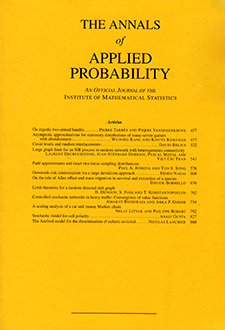Abstract
$\Lambda$-coalescents model the evolution of a coalescing system in which any number of blocks randomly sampled from the whole may merge into a larger block. For the coalescent restricted to initially $n$ singletons, we study the collision spectrum $(X_{n,k}:2\le k\le n)$, where $X_{n,k}$ counts, throughout the history of the process, the number of collisions involving exactly $k$ blocks. Our focus is on the large $n$ asymptotics of the joint distribution of the $X_{n,k}$’s, as well as on functional limits for the bulk of the spectrum for simple coalescents. Similar to the previous studies of the total number of collisions, the asymptotics of the collision spectrum largely depends on the behaviour of the measure $\Lambda$ in the vicinity of $0$. In particular, for beta$(a,b)$-coalescents different types of limit distributions occur depending on whether $0<a\leq1$, $1<a<2$, $a=2$ or $a>2$.
Citation
Alexander Gnedin. Alexander Iksanov. Alexander Marynych. Martin Möhle. "The collision spectrum of $\Lambda$-coalescents." Ann. Appl. Probab. 28 (6) 3857 - 3883, December 2018. https://doi.org/10.1214/18-AAP1409
Information





